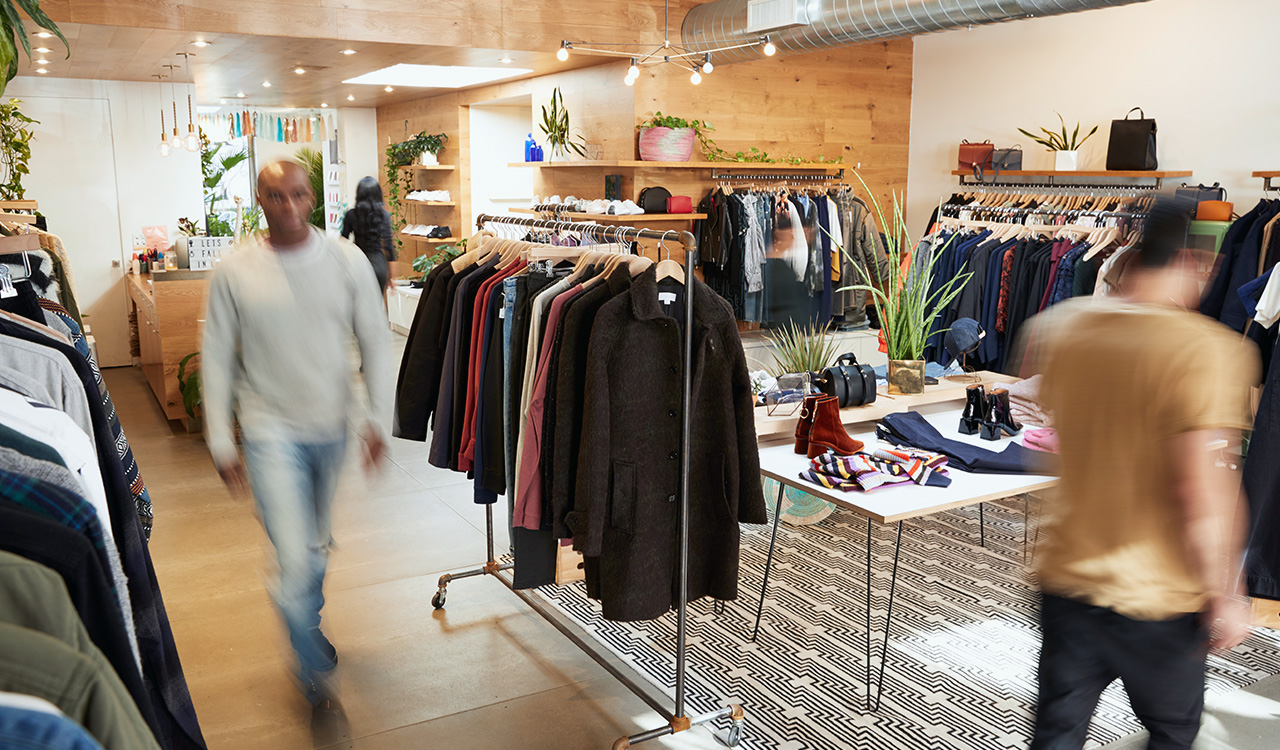At Milan’s Fashion Week this past February, Hong Kong-Japanese fashion label Anteprima showcased knitted garments and a handbag composed of glowing, color-changing fiber-optic-based textiles. The designs had embedded sensors that detected gestures and motions, changing the textile’s colors and patterns accordingly using recognition technology powered by artificial intelligence (AI) algorithms. While gimmicky, the blinking designs do point to some more fundamental, and possibly transformative uses of AI to boost productivity for fashion companies—and burnish Hong Kong’s position as a global center for apparel industry supply chain innovation in the process.
The modern Chinese shopper has likely never seen the inside of a store, so the interface is different. So too is the fulfillment processes: Chinese retail leaders are much more agile, and well-versed in leveraging data from the first mile to the last mile.
AI Fashion Design
Anteprima developed the textiles and its design concept in collaboration with the Laboratory for Artificial Intelligence in Design (AiDLab), jointly run by The Hong Kong Polytechnic University and the UK’s Royal College of Art. AiDLab builds AI-based tools for fashion designers and apparel manufacturers and commercializes them through a marketing and sales arm known as Code-Create. The first such product it launched is AiDA (AI-based Interactive Design Assistant for Fashion), a large language model that generates original fashion designs when prompted with instructions, and a creator’s drawings, sketches and color palates. It has soft-launched this tool with more than a dozen designers and fashion houses from Europe and Asia, including Anteprima and Korean experimental designer label BESFXXK.
Large language models are being used across the apparel supply AI-enabled data management and analytics can speed up operational processes or repair and maintenance cycles, and help product development teams quickly ideate new designs and prototypes. AiDLab estimates that design ideation using generative AI can save fashion designers up to 70 percent of the time invested in new product development, taking the time required to launch a new seasonal clothing line down from several months to a few weeks. AiDA is also developing an AI-based fabric inspection software tool to automate quality control in textile production lines as a software service. “We are beginning at the start of the fashion ecosystem, says Kim Wong, Code-Create’s CEO, “which gives us the ability to collect and leverage data that can be used across the entire value chain.”
Wong uses the example of Mixi, an image search and auto-tagging solution AiDLab initially developed to assist designers select colors and patterns for their collections. Wong now sees the tool developing into an omnichannel online and offline search tool for multi-brand retailers. Online collections can be loaded and organized quickly, and shoppers in department stores can use Mixi to quickly identify fashion items across brands.
Ultimately, explains Dr. Aemika Zou, a project manager at AiDA and an assistant professor at Hong Kong Polytechnic’s School of Fashion and Textiles, “there are three stages at which AI can be deployed to increase productivity. The first is pattern recognition,” which allows marketers and retailers to identify and categorize items more efficiently. This can also be augmented with social media analytics and retail data to understand linkages between consumer trends and sales patterns. “Then there is assisting designers with clothing aesthetics, using generative AI to create more options. The third is in the actual production of garments.”
Tech-Driven Production
Production is an area that has barely been explored, and where significant value can be derived. “There are efficiencies that can be extracted from nearly every process which makes a T-shirt a T-shirt.” says Janice Wang, the CEO of Alvanon (a TRR Partner), a Hong Kong-headquartered fashion technology consultancy, “the key to doing so is in making the most of out the archives.” Wang means that fashion firms typically organize and manage their institutional data poorly, and rarely share data and insight between an organization’s siloes, such as merchandising, distribution and production. Wang sees a future potential long-term goal of fashion AI, where various models’ outputs are linked: generative design processes could be connected to sales analytics and manufacturing processes so that garments can be produced in sizes and volumes that reflect real-time demand.
Alvanon uses machine learning to create “fit tools” (both physical and virtual mannequins), and to optimize client garment purchase volumes. Alvanon is training a large language model on large sets of demographic data to build a representative set of “body shapes which cover the entire world.” This could create extremely precise fit model protocols that more accurately represent the average distribution of body types in a specific regional market. Such a powerful database can also be used to develop software tools that brands can offer customers to better navigate their size selections to select the best fit when shopping.
The Once and Future Hub
A core advantage that Hong Kong’s fashion industry retains is its enduring role as a “command and control” node that sits between global apparel markets and the juggernaut of China’s textile and garment supply chain. Despite years of (primarily U.S. government) efforts to decouple their economies from China’s exports, this has had little effect in shifting its manufacturing dominance in global apparel, In 2022, China Customs data recorded $175bn worth of clothing exports and $145bn in textiles. This is over 41 percent of the global total, according to the WTO, and the OEC estimates that China’s textile exports alone are roughly two-thirds larger than the world’s next four largest exporting countries combined. While the value of China’s garment and textile exports has fallen nearly 10 percent in the first seven months of 2023, this likely has more to do with a flagging post-recovery retail economy than any concerted effort by the world’s apparel industry to wean itself off China.
Hong Kong swiftly rose to become a global textile manufacturing hub in the 1950s fueled by migrant labor from Mainland China., The entrepot has leveraged China connectivity to maintain this role, although it has to redefine its role many times. “There is an incredible density of talent and knowledge of the global fashion industry, and China’s value chain, in Hong Kong,” says Alvanon’s Wang.
“Hong Kong is the king of optimization between the supply chains of East and West,” says Edwin Keh, CEO of the Hong Kong Research Institute of Textiles and Apparel (HKRITA). He notes that there are still over 130 fashion design, production and retail companies listed on the Hong Kong Stock Exchange. This density has also, Keh notes, fuelled the development of a specialized finance industry around trade financing for the apparel sector. Leveraging this ecosystem, HKRITA has been working with predictive analytics to link social media data to sales patterns and has recently conducted an AI/machine learning-based experiment to develop a tool that automatically categorizes discarded, post-consumer clothing for more efficient garment recycling.
Will the Center Hold?
There are, however, numerous challenges that could slow or scupper the AI aspirations of Hong Kong’s fashion industry. The ongoing technology trade war being waged on China by the U.S. (with varying degrees of support from American allies cajoled to its cause) is a chief concern. Over the last half a decade, the federal government has steadily increased sanctions on the sale of semi-conductor and other critical digital technologies to China, as well as prohibitions on joint scientific collaboration in many areas, including AI and machine learning. For the foreseeable future, therefore, it will be difficult for China-based technology firms to collaborate with U.S. and other international firms to develop AI technology, and it will also mean that U.S. fashion firms which bring machine learning-based tools to bear in their Hong Kong and China operations may find them incompatible. (To date, most U.S. open-access Generative AI models such as ChatGPT are not accessible in Hong Kong and China.)
Hong Kong’s fashion industry participants believe, however, that its primary asset—a concentration of talent, finance and connections—forms a center of gravity that will allow industry participants to overcome these challenges. “Global fashion is moving from being an art to a science,” notes HKTRITA’s Keh, and the ability to develop and use digital tools will determine which companies make that shift most efficiently and profitably. He points to Chinese fast fashion giant Shein –“the company everyone loves to hate right now”– and its Hong Kong-headquartered online sales platform Zoetop Business as exemplars. Much of this has to do with how well they have leveraged the data and experience gained in Asia’s digitally native market dynamics: “The modern Chinese shopper has likely never seen the inside of a store, so the interface is different. So too is the fulfillment processes: Chinese retail leaders are much more agile, and well-versed in leveraging data from the first mile to the last mile.”
While Ker concedes that Shein or other regional fashion retailers may not be currently deploying AI at scale, “if you look at the speed of their fulfillment, the volume and variety of their product, you have to assume that their processes are largely automated.” The speed with which Hong Kong-linked retailers and brands capture market information and trends and incorporate them into turning around product quickly, Ker believes, is an invaluable competency that will create an AI center of excellence. Hong Kong has made proximity to the garment industry a competitive advantage; now it must make its growing familiarity with the digital tools increasingly integrated into the fashion industry “allow Hong Kong to reinvent itself … again.”




